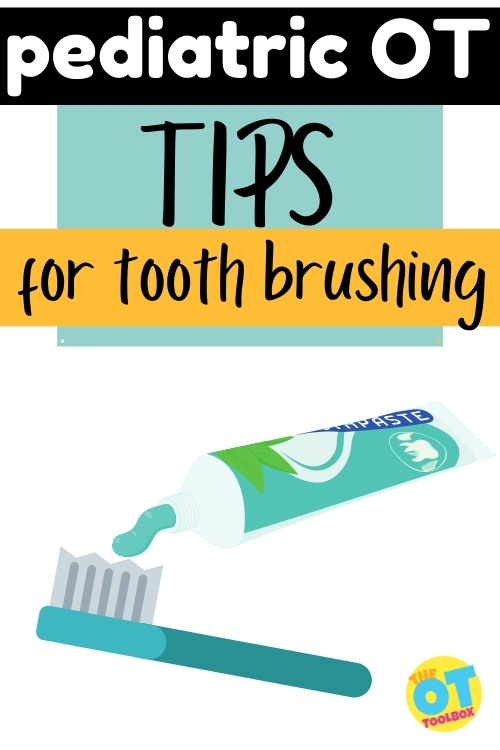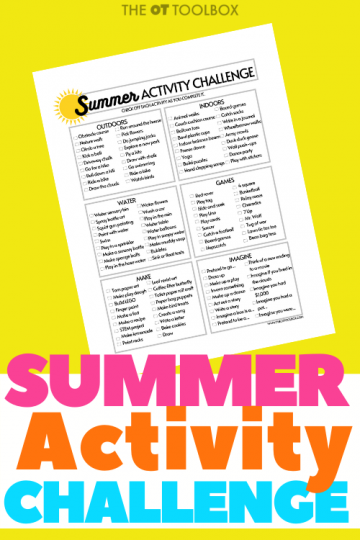Is toothbrushing a nightmare in your house? Sensory related toothbrushing issues can be! Need some sensory tooth brushing tips? For individuals with sensory difficulties, toothbrushing challenges mean more than cavities, plaque build up, and gum sensitivities. Sensory toothbrushing issues can lead to meltdowns, anxiety, and daily struggles with nightly and morning routines. Does your child cry when it’s time to brush their teeth? Do you know, or suspect, that they have some sensory challenge with brushing their teeth?

sensory tooth brushing tips for kids
Brushing teeth is an ADL that can be a challenge for many kids whether it’s from sensory processing challenges, challenges with routine, anxiety, or any other variety of reasons.
This is an area that an occupational therapist (OT) can help you with, by helping you set up a home program to make brushing your child’s teeth easier. Check out the tips below to help make tooth brushing easier for your family!
These toothbrushing tips are interventions for making brushing teeth easier, or strategies for helping with sensory challenges that impact tooth brushing.
Teaching dental hygiene to preschoolers or older learners addresses a daily occupation. Incorporate these tips and recommendations daily to impact independence with tooth brushing.
Amazon affiliate links are included below.

Tip # 1: Use a Visual Schedule
Adding a visual picture schedule can help reduce stress and anxiety during teeth brushing by providing clear expectations of what’s going to come next. It also helps to reduce the auditory input for following directions, helping your learner focus on the task at hand.
Another perk of using a tooth brushing visual schedule is that it ensures that the same routine is used every time that tooth brushing occurs. This can also help to reduce stress and anxiety by ensuring that the child knows what’s coming next. Which brings us to tip # 2!
Tip # 2: Create and Use a Consistent Routine
Create a routine that works for you and your family! It can evolve over time, so don’t worry if it’s not exactly what you want it to be right away. Having a routine helps take away anxiety around the unknown, and establishes what to expect during the situation.
Once you determine what works, plan to utilize the same language, visuals, toothbrush and toothpaste every time you work on toothbrushing.
It will also be helpful to complete this toothbrushing routine around the same time every day. It doesn’t have to be rigid in that you brush teeth every night at 5pm, but should always follow an event like a meal, or when you first wake up in the morning.
Consistency and practice is key!
Bonus Tip! Make sure that when you’re done with the toothbrushing routine, follow it up with a fun activity like play or a preferred game.
Tip # 3: Use a Timer
Similar to creating a routine, using a timer helps to take fear of the unknown out of the picture. It also helps your child see that there is an end in sight to the activity. (Amazon affiliate link) Timers, or counting, are great to pair with a visual schedule. This nighttime toothbrush schedule offers more tips.
Tip # 4: Sing a Song
If a timer causes too much stress or becomes an object of fixation, you can play a song or count to 10 for each side of mouth, top and bottom.
Brush to the tune of 1, 2, buckle my shoe or any other preferred tune or song that is easily broken into small chunks for brushing each quadrant of the mouth.
Tip # 5: Use a Vibrating Toothbrush
For sensory seeking children, a vibrating toothbrush is a great way to engage them in toothbrushing! Not only do they get stimulation that they are seeking, they also get a thorough teeth cleaning with the vibration.
Using a vibrating toothbrush does not need to be solely at toothbrushing time. It can be used anytime during the day.
There are cost-friendly options at most grocery stores and large box stores for families that are concerned with the cost of getting an electric toothbrush, or feel that their child won’t use it.
Tip # 6: Flavored Toothpaste
Flavored toothpaste brings an element of fun to a task that can feel like a chore. To add an extra layer of fun, and to encourage buy in from your child, go shopping together for new toothpaste. Get a few different flavors to try, and to have on hand in a pinch if the “preferred” flavor becomes boring or there is resistance to using it.
Bonus Tip! Offering choices during an challenging activity such as brushing teeth, gives your child some sense of control of the situation.
Tip # 7: Mouthwash that Shows the Plaque
Like flavored toothpaste, mouthwash is another tactic to help get buy-in from your child. Listerine Smart Rinse or Plaque Disclosing Tablets are a couple of the many great products that help your child see where the plaque is.
Once they see where the plaque is, make a game out of cleaning all the “junk” out of their mouth. For kids that are older, you can use the visual the mouthwash gives to start talking about cavities, and the effects of not cleaning your teeth.
Tip #8: Brush Only One Time Per Day
The American Dental Association recommends tooth brushing twice a day. However, for kids that this task is extremely distressing, sometimes one REALLY good brushing a day is a success, and is a great start, and can be built upon.
The second time a day can, and should, still be attempted, but can have less focus on quality, as you build the child’s tolerance to the task.
The second time a day may have more focus on going through the motions, such as talking about the steps, doing a dry run, or if your child is emotionally regulated enough, attempting to brush their teeth.
Tip # 9: Take Turns Brushing
Helping your child with tooth brushing can take away stress over the motor component of coordinating hand to mouth, and challenges with completing multiple steps needed for toothbrushing.
Taking turns during the tooth brushing process, your child brushing one time a day and you brushing their teeth the second time, can give back some control and insure at least one time a day is done thoroughly. This is a great way to incorporate turn taking lessons into functional performance of the essential life skill of brushing teeth!
Find what works for you and your child!
Tip #10: Use a Water Pick
If a toothbrush is still causing too much frustration, stress and anxiety, a good option is to change the tool completely, and try to reset the routine and behaviors. This is where a water pick is really great!
While the water jet can be overstimulating and noxious to some, others may find it less so than tooth brushing.
Implementing Tooth Brushing Tips
These tips can help to break any negative behaviors or emotions that may surround your child’s tooth brushing routine, and give you a foundation to start a fresh routine. Start by trying one recommendation that you think will work for your child, give it a week and if it’s still not working try another. Working through toothbrushing challenges takes time and is a trial-and-error process. Hopefully you find these tips helpful!
Using tools like a sensory brush or sensory diet tools can help depending on specific needs of the individual.
Related hygiene tasks:
Incorporate these hygiene and grooming tasks and recommendations:
- Sensory Issues with brushing hair
- Hand Washing tips
- Sleep Hygiene
- Nose Blowing Tips
- Bedtime Toothbrushing Schedule
For specific ways to integrate sensory needs into a daily lifestyle, check out the Sensory Lifestyle Handbook. This resource uses not only a sensory diet strategy into daily activities, but it offers tools and resources to create a sensory lifestyle that uses motivating and meaningful daily tasks to offer much-needed sensory input so individuals can function throughout their day.
Toothbrush Social Story
Another tip that I wanted to add is using a brushing your teeth social story. I love using social stories with my kids because it makes the task relatable and meaningful. Ideally, the social story you create has pictures from the child’s bathroom and includes details about their personal lives, like morning routines or evening routines. This makes a social story about brushing teeth very powerful because it’s the child’s personal task in picture and word form.
Some key components of a social story about toothbrushing might include:
- In the morning and at night, I brush my teeth.
- I use my toothbrush.
- First, I rinse the bristles to get them wet.
- Then, I squeeze just a little toothpaste on the brush. It should be about the size of a pea. If I squeeze too much toothpaste, it will fall off the bristles.
- Then I brush my teeth up and down and forward and back.
- I make sure to brush all the way in the back.
- I also brush my tongue.
- When I have brushed my teeth for (set amount of time), then I rinse my mouth with water. I spit the water into the sink.
- Then I rinse the toothpaste off my toothbrush.
Every social story will be slightly different, depending on the individual’s needs and routines. These basics can be used to create a toothbrushing social story that works for the individual.
Brushing Teeth Story
A social story that is individualized might work best, however, I have also seen kids use a picture book or a general story (social story or even videos) be very helpful too! For example, one individual that I worked with really liked reading a picture book just before bedtime. Then they would brush their teeth and the story in the book was part of that routine that they created before bed. One book that is great for this is Brush! Brush! Brush! (Amazon affiliate link) because it has simple wording and nice pictures to teach the steps of toothbrushing.
We also made this video on the steps of toothbrushing. It’s a take on a social story because it walks through the steps, but it is more of a story. There are characters in the video: Tommy Toothbrush, Pasty Paste, and the Icky Plaque Monsters.
In the video, as we brush teeth, Tommy Toothbrush is on a journey to battle the dreaded Icky Plaque Monsters and learn the importance of proper dental hygiene along the way. Kids can follow the storyline as Tommy and Pasty team up to fight off the pesky plaque monsters threatening their dental health. With the help of their trusty toothbrush and toothpaste, they’ll demonstrate the step-by-step process of brushing teeth while overcoming obstacles and learning valuable lessons.
This video is perfect for parents or therapy professionals supporting kids who are learning to brush their teeth or for parents and educators looking for a fun way to reinforce good oral hygiene habits.
One last toothbrushing tip that we mention is to earn superhero points toward a healthy brushing badge. You can use any type of reward system like a sticker chart or other visual reward chart for each time the child brushes their teeth. This is a great visual prompt for toothbrushing!
This toothbrushing story is one of our first videos on life skills…more to come!
If you can’t view the video, we have it on YouTube as well:
Whether you are using a toothbrushing social story, sensory strategies, or some of the other toothbrushing tips we’ve listed, a routine will help with this life skill!

Contributor: Kaylee is a pediatric occupational therapist with a bachelors in Health Science from Syracuse University at Utica College, and a Masters in Occupational Therapy from Utica College. Kaylee has been working with children with special needs for 8 years, and practicing occupational therapy for 4 years, primarily in a private clinic, but has home health experience as well. Kaylee has a passion for working with the areas of feeding, visual development, and motor integration.






